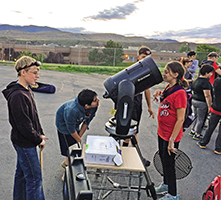
Rural Districts Can Be Pacesetters in STEM
BY BARBARA PETERSON/
School Administrator, May 2017
 |
Middle school students in Tonasket, Wash., set up telescopes for evening observations.
|
Tonasket, Wash. (pop. 1,032), sits near the Canadian border, 260 miles east of Washington’s Silicon Forest outside of Seattle, location of most of the state’s technology corporations. The Tonasket School District, however, is not letting its distance prevent its students from pursuing careers in the sciences, technology, engineering and math.
Over the last few years, Tonasket, which has 1,050 students in its K-12 system, has become a model for rural strategies to promote STEM interests and STEM education. Its middle school currently boasts two class sections of robotics, with 14 middle and three high school VEX Robotics teams competing in area competitions. Six Tonasket teams qualified to compete in VEX world competitions in Louisville, Ky., this spring, with one team entering the competition ranked 49th in the world.
Meanwhile, a science teacher at Tonasket High School, Carissa Haug, a chemist who left her industrial workplace to “give back,” she said, to public education, now teaches two semester-long sections of middle school engineering to 300 students each year. Her students use a middle school engineering curriculum “Engineering Everywhere,” designed by the Museum of Science in Boston. Units in the course include vertical farming, biodegradable plastics and animal prosthetics.
With Tonasket’s access to unfettered views of the rural night sky, two teachers, 15 students and five Tonasket community members participate in the RECON project (Research and Education Cooperative Occultation Network), a National Science Foundation project supervised by Cal Polytechnic. They use powerful telescopes to observe and map portions of the Kuiper Belt, contributing real learning to a national space database.
Hands-on Partnerships
To help recruit rural students to expanding job opportunities in the field of medicine, Tonasket has partnered for two years with nearby North Valley Hospital to build an outreach and training program for a nursing certification program with others pending.
Tonasket also is one of four area school districts studying the impact of recent area wildfires through a robust partnership between scientists and schools. For the past two summers, student teams from Wenatchee, Manson, Chelan and Tonasket have been dispatched to collect, test and monitor evidence of fire damage, deforestation, soil erosion and water quality. In this multi-year effort, students learn the scientific method, job shadow STEM professionals, collect data and contribute to real science databases, building both a passion and a solid application for STEM careers.
As Tonasket Superintendent Steven McCullough notes, “Being rural doesn’t mean a lack of STEM opportunities. My job is to help students locate them.”
As Tonasket and its neighboring districts show, rural communities abound with opportunities for students of all ages to tackle real-world science and engineering problems, making STEM relevant to their daily lives.